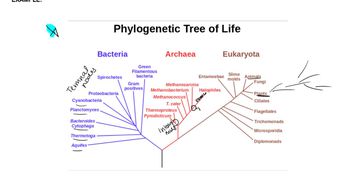Which of the following is an example of natural selection?
Table of contents
- 1. Introduction to Genetics51m
- 2. Mendel's Laws of Inheritance3h 37m
- 3. Extensions to Mendelian Inheritance2h 41m
- 4. Genetic Mapping and Linkage2h 28m
- 5. Genetics of Bacteria and Viruses1h 21m
- 6. Chromosomal Variation1h 48m
- 7. DNA and Chromosome Structure56m
- 8. DNA Replication1h 10m
- 9. Mitosis and Meiosis1h 34m
- 10. Transcription1h 0m
- 11. Translation58m
- 12. Gene Regulation in Prokaryotes1h 19m
- 13. Gene Regulation in Eukaryotes44m
- 14. Genetic Control of Development44m
- 15. Genomes and Genomics1h 50m
- 16. Transposable Elements47m
- 17. Mutation, Repair, and Recombination1h 6m
- 18. Molecular Genetic Tools19m
- 19. Cancer Genetics29m
- 20. Quantitative Genetics1h 26m
- 21. Population Genetics50m
- 22. Evolutionary Genetics29m
21. Population Genetics
Allelic Frequency Changes
Problem 1e
Textbook Question
How do we know the age of the last common ancestor shared by two species?
 Verified step by step guidance
Verified step by step guidance1
Understand that the age of the last common ancestor shared by two species is estimated using molecular clock techniques, which rely on the accumulation of genetic mutations over time.
Identify homologous DNA or protein sequences from the two species to compare their genetic differences; these sequences should be orthologous (derived from a common ancestor).
Calculate the number of genetic differences (mutations) between the sequences, often measured as the number of nucleotide substitutions per site.
Use a known mutation rate (substitutions per site per year) for the gene or genomic region studied to convert the genetic distance into an estimate of divergence time.
Apply the formula , where is the time since the last common ancestor, is the genetic distance, and is the mutation rate, to estimate the age of the last common ancestor.
 Verified video answer for a similar problem:
Verified video answer for a similar problem:This video solution was recommended by our tutors as helpful for the problem above
Video duration:
1mPlay a video:
Was this helpful?
Key Concepts
Here are the essential concepts you must grasp in order to answer the question correctly.
Molecular Clock Hypothesis
The molecular clock hypothesis posits that genetic mutations accumulate at a relatively constant rate over time. By comparing genetic differences between two species, scientists can estimate the time since their last common ancestor by calibrating mutation rates with known fossil records or geological events.
Recommended video:
Guided course

Translation:Wobble Hypothesis
Phylogenetic Analysis
Phylogenetic analysis involves constructing evolutionary trees based on genetic or morphological data to infer relationships among species. By examining shared and divergent traits, researchers can identify common ancestors and estimate divergence times between species.
Recommended video:
Guided course

Phylogenetic Trees
Genetic Variation and Mutation Rates
Genetic variation arises from mutations, which occur at measurable rates. Understanding these mutation rates is essential for estimating evolutionary timelines, as they provide the basis for calculating how long ago two species diverged from a common ancestor.
Recommended video:
Guided course

Genomic Variation
Related Videos
Related Practice
Multiple Choice
425
views
4
rank


